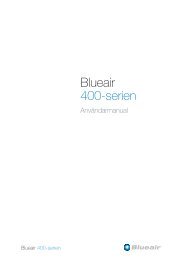Blueair product brochure (pdf)
Blueair product brochure (pdf)
Blueair product brochure (pdf)
You also want an ePaper? Increase the reach of your titles
YUMPU automatically turns print PDFs into web optimized ePapers that Google loves.
10 tips for choosing<br />
the best air purifier<br />
1 Filter efficiency<br />
When selecting an air purifier, consider performance first.<br />
Compare air purifiers using the Clean Air Delivery Rate<br />
(CADR). This measures how well a system removes<br />
pollutants from the air. The higher the CADR test numbers,<br />
the better the unit cleans indoor air.<br />
2 Capacity<br />
Measure the size of the room where you want to purify air.<br />
Choose a unit that can handle the total volume of air in the<br />
room. Remember that high ceilings affect the total cubic<br />
footage. Use the Association of Home Appliance Manufacturers<br />
(AHAM) recommended room size to choose the correct<br />
unit.<br />
3 Health concerns<br />
Air purifiers can improve air quality for those with allergies,<br />
asthma and other respiratory conditions. <strong>Blueair</strong>’s HEPA<br />
Silent filters capture 99.97% of the smallest particles from<br />
dust, pollen and pet dander to tobacco smoke and viruses.<br />
4 Legitimacy of manufacturer claims<br />
When comparison shopping, AHAM is the most reliable<br />
source of unbiased information. <strong>Blueair</strong> purifiers are AHAM<br />
certified in performance tests that are recognized as accurate<br />
and impartial by the EPA, the Federal Trade Commission<br />
and the American Lung Association.<br />
5 Indoor environmental factors<br />
Environmental conditions impact a purifier’s performance<br />
and maintenance requirements. <strong>Blueair</strong>’s HEPASilent filters<br />
counter mold and bacterial growth without filter<br />
sterilization or the addition of chemicals.<br />
6 Operating cost<br />
Check the manufacturer’s recommended filter replacement<br />
interval and costs. Generally, the most effective units are<br />
also the most costly to purchase and maintain on a daily<br />
basis. Look for the unit’s energy use, expressed as watts.<br />
7 Construction quality<br />
Check the warranty to make sure it covers internal components,<br />
such as fans and blowers. The unit should be certified<br />
for <strong>product</strong> safety by organizations such as the Underwriter’s<br />
Laboratory or ETL.<br />
8 Ease of Use<br />
Replacing filters and periodic internal cleaning can require<br />
weekly additives, filter washing, heavy lifting and special<br />
tools. Other air purifiers have maintenance regimens that<br />
simply require a filter change. Select an air purifier that meets<br />
your requirements.<br />
9 Warranty<br />
Make sure that the air purifier carries a solid warranty. Most<br />
established manufacturers offer warranties ranging from<br />
three to five years.<br />
10 Bells and whistles<br />
• Confirm claims of a “whisper quiet” unit with specific noise<br />
values, expressed in decibels (dBA).<br />
• Don’t assume that a large unit is more effective or that<br />
a small unit is less effective. Select a unit based on<br />
efficiency and air volume capacity.<br />
• Most units require specific clearance from walls and windows<br />
to operate effectively, so don’t forget to check the<br />
operating instructions for advice on air purifier placement.




